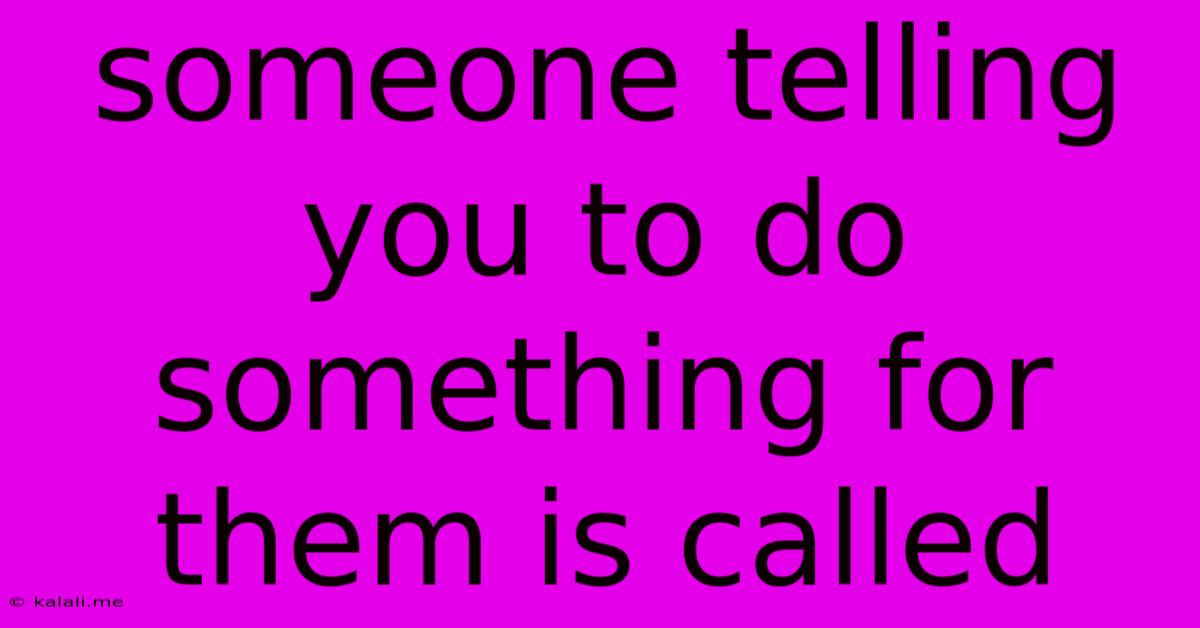Someone Telling You To Do Something For Them Is Called
Kalali
May 31, 2025 · 3 min read

Table of Contents
Someone Telling You to Do Something for Them is Called... a Request! Understanding Different Types of Requests and How to Respond
Have you ever been asked to do something? It's a fundamental part of human interaction, and while seemingly simple, the terminology around it can be surprisingly nuanced. This article explores the various ways someone might ask you to do something, the underlying dynamics, and how best to respond. We'll delve into the subtle differences between requests, demands, orders, and suggestions.
The most common and generally accepted term for someone asking you to do something for them is a request. A request implies a polite and often indirect approach, acknowledging that you have the autonomy to accept or decline. It's a collaborative process, built on mutual respect and understanding.
Types of Requests: A Spectrum of Interactions
While "request" covers a broad spectrum, let's examine some related terms and the contexts in which they're used:
-
Request (Formal & Informal): This is the umbrella term. A formal request might be written, while an informal request is typically verbal and casual. Examples include: "Would you mind helping me with this?" or "Could you please pass the salt?"
-
Demand: Unlike a request, a demand implies a lack of choice. The person making the demand expects compliance, often without consideration for your feelings or obligations. It's an assertive, sometimes aggressive, communication style. Example: "I need you to finish this report by tonight!"
-
Order: This is a directive, often given by someone in a position of authority. It carries an expectation of immediate obedience. Examples: "Clean your room!" or "Report to my office at 10 AM."
-
Suggestion: A suggestion proposes an idea without demanding action. It offers a choice, leaving the decision entirely up to you. Example: "You might want to try this approach."
-
Command: This is a more forceful version of an order. It often implies immediate action and little room for negotiation.
Understanding the Nuances of Communication
The key difference lies in the power dynamic and the level of respect shown. A request acknowledges your agency, while a demand or order attempts to override it. Understanding these nuances is crucial for effective communication and building healthy relationships.
How to Respond Effectively
Your response will depend heavily on the type of request and your relationship with the person making it.
-
For requests: Politely respond with acceptance or a well-reasoned explanation for declining. Examples: "Certainly, I'd be happy to help," or "I'd love to, but I'm already committed to something else."
-
For demands or orders: Assert your boundaries respectfully. You might say: "I understand you need this, but I have other priorities. Let's discuss how we can best manage this workload."
-
For suggestions: Express appreciation for the idea and consider it carefully.
Effective communication requires clarity, respect, and an understanding of social dynamics. Recognizing the subtle differences between a simple request and a forceful demand empowers you to navigate interactions more effectively and build stronger relationships. Remember, clear communication fosters mutual respect and understanding.
Latest Posts
Latest Posts
-
League Of Legends Chase The Red Dot Is Broken
Jun 02, 2025
-
New York Strip Steak Vs Kansas City
Jun 02, 2025
-
What Was The Crown Of Thorns Made Of
Jun 02, 2025
-
Do You Have To Sand A Deck Before Staining
Jun 02, 2025
-
Wiring An Outlet To A Switch
Jun 02, 2025
Related Post
Thank you for visiting our website which covers about Someone Telling You To Do Something For Them Is Called . We hope the information provided has been useful to you. Feel free to contact us if you have any questions or need further assistance. See you next time and don't miss to bookmark.